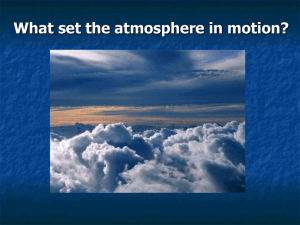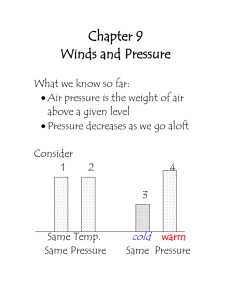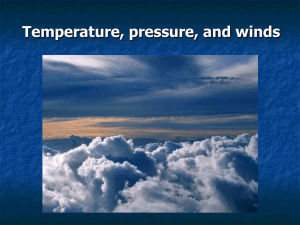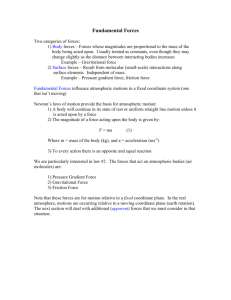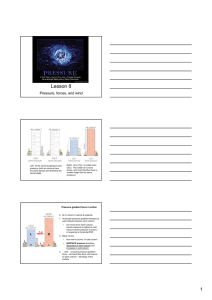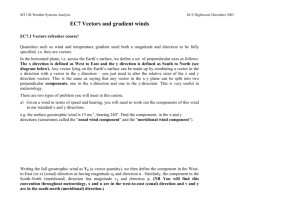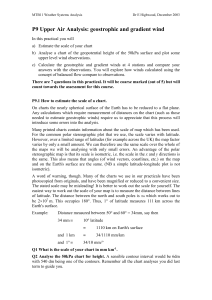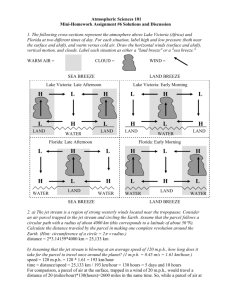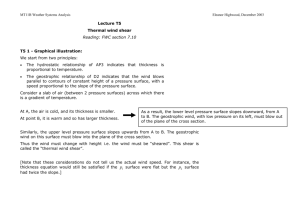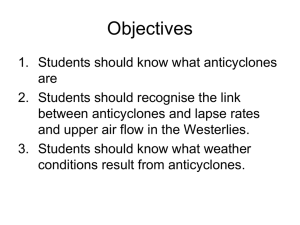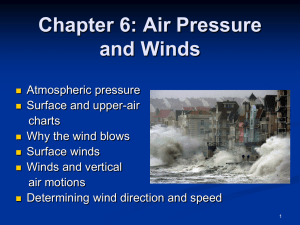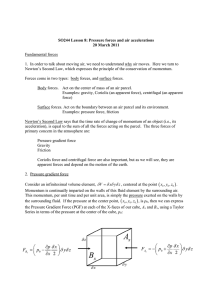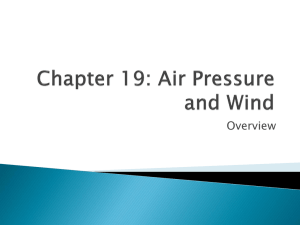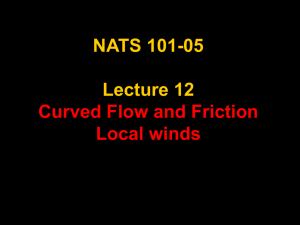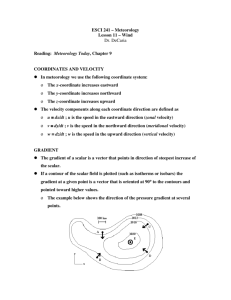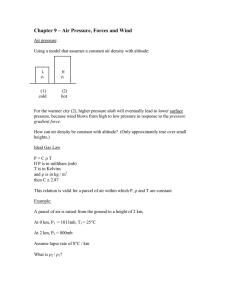Lecture D3 Gradient Wind Balance
advertisement
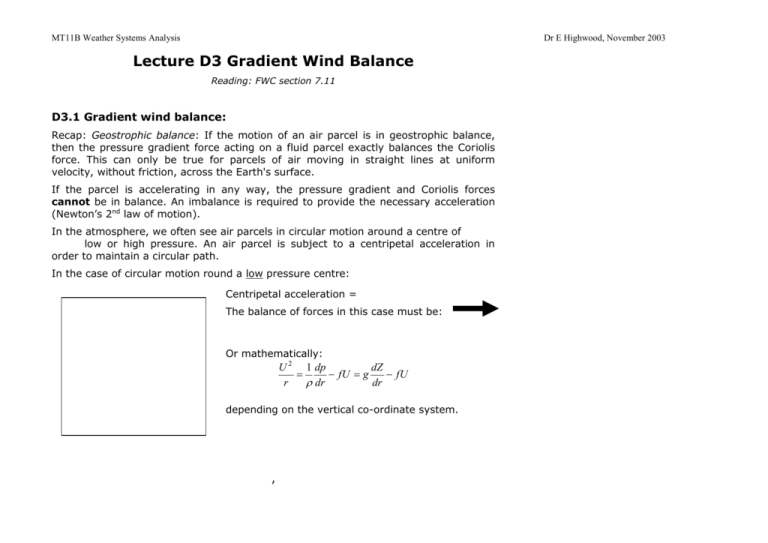
MT11B Weather Systems Analysis Dr E Highwood, November 2003 Lecture D3 Gradient Wind Balance Reading: FWC section 7.11 D3.1 Gradient wind balance: Recap: Geostrophic balance: If the motion of an air parcel is in geostrophic balance, then the pressure gradient force acting on a fluid parcel exactly balances the Coriolis force. This can only be true for parcels of air moving in straight lines at uniform velocity, without friction, across the Earth's surface. If the parcel is accelerating in any way, the pressure gradient and Coriolis forces cannot be in balance. An imbalance is required to provide the necessary acceleration (Newton’s 2nd law of motion). In the atmosphere, we often see air parcels in circular motion around a centre of low or high pressure. An air parcel is subject to a centripetal acceleration in order to maintain a circular path. In the case of circular motion round a low pressure centre: Centripetal acceleration = The balance of forces in this case must be: Or mathematically: U 2 1 dp dZ fU g fU r dr dr depending on the vertical co-ordinate system. , MT11B Weather Systems Analysis Dr E Highwood, November 2003 It is simpler to write this relationship in terms of a hypothetical “geostrophic wind speed” U g where: fU g 1 dp dZ . g dr dr Then, the gradient wind balance can be expressed as: U2 fU g fU . r (Eq. 1) And the gradient wind is sub-geostrophic (by up to 20% in vigorous extra-tropical cyclones). “Cyclostrophic balance” occurs for very large Ug where the centripetal acceleration is entirely provided by the PGF (i.e. CF is small). In what situations might this be important and why? In the case of circular motion around a high pressure centre: PGF away from centre, CF towards centre. Centripetal force must still be towards the centre so CF > PGF. U2 Then for an anticyclone: fU fU g r Which can be rearranged to give: U 2 ( fr)U ( fr)U g 0 MT11B Weather Systems Analysis Dr E Highwood, November 2003 Now, this can be made to look exactly like the equation for a cyclone (Eq 1) if we define r as negative for an anticyclonic situation. Then we can solve the quadratic equation in the usual way to give the roots 1 fr fr 4U g 2 . U 1 2 2 fr (Eq. 2) in either case, so long as r is defined as negative in the case of anticyclones. There are two things we need to know in order to use this equation practically. 1. The term under the square root must be positive or there will be no real roots, so that in the case of the anticyclone, where r is negative, Ug 4U g f r 1, rf , and there is a maximum geostrophic wind speed which cannot be exceeded in 4 an anticyclone. Substituting this criteria back into the equation (2) gives a maximum speed of U=2Ug. Q. What use is this to us when analysing charts for anticyclones? 2. The decision whether to use the + or – root depends on the situation. Bearing in mind that U is a speed and therefore must be both real and positive: Cyclone: r is +ve, so to get U +ve we must take +ve root Anticyclone: r is –ve, and 1 4U g fr 1 , so if we took the +ve root the system would have negative absolute angular momentum, which is something that only happens occasionally near the equator. But taking the –ve root allows the system to have positive angular momentum when r is negative. MT11B Weather Systems Analysis Dr E Highwood, November 2003 Revision Summary Cyclones Anticyclones How does U compare to Ug ? Is there a maximum value to Ug or U? What does this mean for analyses that you draw? D3.2- Effects of friction: The friction force at the ground generally acts in the opposite direction to the velocity vector, acting to slow air parcels down. A balance of forces between CF, PGF and FD can be achieved if the parcel moves at an angle to the isobars, drifting towards low pressure (Remember Lecture AP2). Simplified expression for friction force is known as “Rayleigh friction”: FD v D where D is ? We can work out a value for D and for the windspeed by resolving forces. MT11B Weather Systems Analysis Dr E Highwood, November 2003 If the angle between the velocity vector and the isobars is , then resolving forces parallel to the isobars gives: FD cos Fc sin or tan FD 1 . Fc f D Resolving forces at right angles to the direction of motion determines the magnitude of the velocity: Fp cos Fc or U U g cos . A more accurate parametrization would have the friction force increasing as the square of the wind speed. NB A parametrization is just a simplified expression used to represent complex physics.
